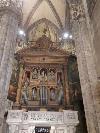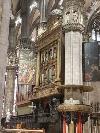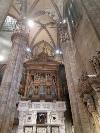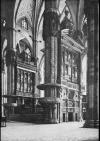Ausführliche Beschreibung der vorgewählten Orgel
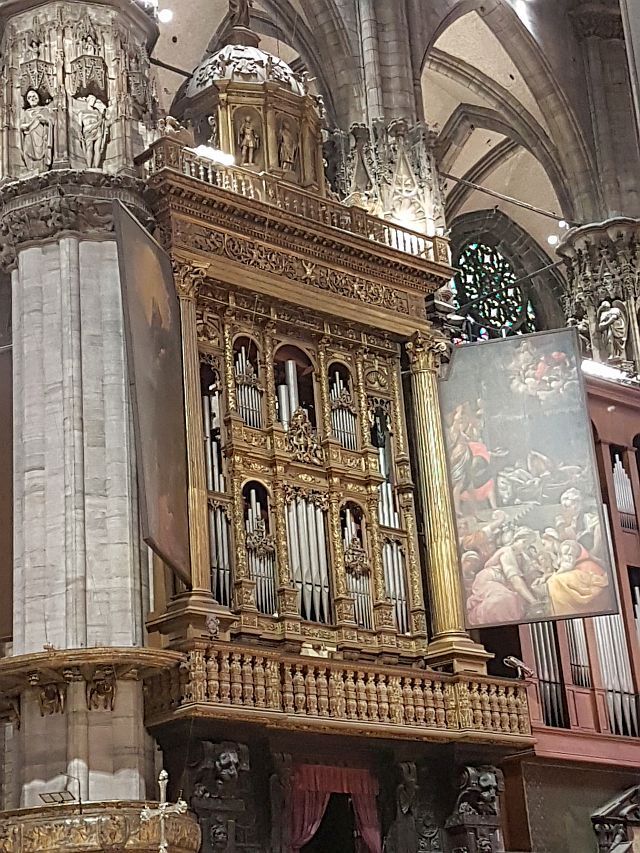
Bild: Michiel van 't Einde
Milano, Italia (Milano) - Duomo Mariae Nascenti
Gemeinde: Milano
Region:Lombardia
Adresse: Piazza del Duomo, 20122, Milano
Website: http://www.duomomilano.it/
Beschreibung nr.: 2001891.
Gebaut von: Famiglia Organaria Mascioni, Giovanni Tamburini und Balbiani Vegezzi Bossi (1938)
Die Orgel enthält älteren Material: aus 1577 von Gian Giacomo Antegnati, aus 1590 von Cristofaro Valvassori
Technische Daten
Disposition
Grand' Organo (Manuale II) (C-c''''):
Nord: Principale 32', Principale I 16', Principale Major 8', Principale Diapason 8', Bordone 8', Ottava Forte 4', Flauto in Ottava 4', Decimaseconda 2 2/3', Decimaquinta 2', Flauto in XV 2', Decimanona 1 1/3', Cornetto 4 file, Ripieno 10 file, Tuba Forte Sonorità 8', Tuba Major 8', Clarinetto 8', Tromba Armonica 8', Trombina 4'.
Sud: Principale II 16', Principale Violone 16', Principale Forte 8', Flauto Aperto 8', Viola Armonica 8', Viola Umana 8', Ottava 4', Flauto Ottaviante 4', Decimaseconda 2 2/3', Decimaquinta 2', Flauto in XVII 1 3/5', Decimanona - Vigesimaseconda 1 1/3'+1'', Ripieno 10 file, Tromba 16', Tromba 8'.
Positivo (Manuale I) (C-c''''): Principale Violone 16', Bordone 16', Principale I 8', Principale II 8', Gemshorn 8', Flauto a Camino 8', Flauto Conico 8', Viola da Gamba 8', Salicionale 8', Unda Maris 8', Ottava 4', Flauto Doppio 4', Fugara 4', Decimaseconda 2 2/3', Nasardo 2 2/3', Flagioletto 2', Terza di Nasardo 1 3/5', Piccolo 1', Decimaquinta-Decimanona 2'+1 1/3'', Ripieno 5 file, Ripieno 6 file, Corno di Bassetto 16', Corno Inglese 8', Tuba Mirabilis 8', Tromba Armonica 8', Chiarina 4', Tremolo.
Recitativo Espressivo (Manuale III) (C-c''''): Principale Armonica 16', Controgamba 16', Principale 8', Principale Diapason 8', Eufonio 8', Bordone 8', Flauto Celeste 8', Viola d'Orchestra 8', Ottava 4', Flauto in Selva 4', Flauto Ottaviante 4', Fonino 4', Salicet 4', Flauto in XII 2 2/3', Decimaquinta 2', Flautino 2', Larigot 1 1/3', Mixtur 3 file, Scharf 3 file, Zimbel 2 file, Concerto Violini 4 file, Gran Concerto Viole, Controtuba 16', Tromba di Corno 8', Tuba 8', Oboe 8', Cornamusa 8', Tuba 4', Corale Angelica 2 file, Tremolo.
Solo Espressivo (Manuale IV) (C-c''''): Principale 16', Quintante 16', Principale Stentor 8', Flauto a Camino 8', Gamba Serafona 8', Armonica 8', Flauto Solista 8', Viola Celeste 8', Flauto in Quinta 5 1/3', Principalino 4', Tibia Major 4', Fugara 4', Flauto Ottaviante 4', Grosse Tierce 3 1/5', Squillante 2', Sesquialtera 2 file, Mixtur 6 file, Coro d'Archi 5 file, Corno Orchestrale 8', Corno Inglese 8', Tuba Trionfale 8', Cornetto di Fanfara 5 1/3', Chiarina 4', Tremolo.
Eco Espressivo (Manuale V) (C-c''''): Gemshorn 16', Principale Aperto 8', Principale Conico 8', Voce Angelica 8', Corno di Notte 8', Viola d'Amore 8', Ottava Armonica 4', Flauto Silvestre 4', Flauto in XII 2', Flautino 2', Armonia Eterea 5 file, Concerto Violini 4 file, Corno Francese 8', Oboe d'Eco 8', Tremolo.
Organo Corale (Manuale III) (C-c''''): Principale 8', Violoncello 8', Flauto a Camino 8', Bordone 8', Ottava 4', Principalino 4', Decimaquinta 2', Ottava 2', Ripieno 4 file, Cimbalino 2 file.
Pedale (C-g'):
Pedale Prima Tastiera: Principale 24', Contrabbasso 16', Violone 16', Subbasso 16', Basso Armonico 8', Ottava 4', Corno Bassetto 16', Tromba 8', Clarino 2'.
Pedale Seconda Tastiera - Nord: Gravissima 64', Principale Acustico 32', Principale 16', Subbasso 16', Principale 8', Bordone 8', Ottava 4', Bordoncino 4', Controfagotto 16'.
Pedale Seconda Tastiera - Sud: Contrabbasso 32', Contrabbasso 16', Gran Quinta 10 2/3', Basso forte 8', Quinta 5 1/3', Controbombarda 32', Bombarda 16', Tromba 8', Clarone Forte 4'.
Pedale Terza Tastiera: Principale Armonico 16', Basso Violone 8', Subbasso 16', Bordone 8', Violoncello 8', Fugara 4', Controtuba 16', Tuba 8', Subbasso 16', Bordone 8', Basso 8', Clarone 4'.
Pedale Quarta Tastiera: Principale 24', Principale Stentor 16', Tibia 16', Armonica 16', Basso Forte 8', Principalino 8', Tuba Profonda 16', Tuba 8', Trombina 4'.
Pedale Quinta Tastiera: Flauto 16', Basso d'Eco 8', Flauto 4'.
Nebenregister und Spielhilfen: 3025 Combinazioni Aggiustabili.

Bild: Michiel van 't Einde
Milano, Italia (Milano) - Duomo Mariae Nascenti
Gemeinde: Milano
Region:Lombardia
Adresse: Piazza del Duomo, 20122, Milano
Website: http://www.duomomilano.it/
Beschreibung nr.: 2001891.
Gebaut von: Famiglia Organaria Mascioni, Giovanni Tamburini und Balbiani Vegezzi Bossi (1938)
Die Orgel enthält älteren Material: aus 1577 von Gian Giacomo Antegnati, aus 1590 von Cristofaro Valvassori
| Jahr | Orgelbauer | Opus | Aktivität | 1577 | Gian Giacomo Antegnati | Neubau | 1590 | Cristofaro Valvassori | Neubau | 1842 | Fratelli Serassi | Neubau im alten Gehäuse | 1907 | Famiglia Organaria Mascioni | Neubau im alten Gehäuse | 1938 | Famiglia Organaria Mascioni | Neubau | 1938 | Giovanni Tamburini | Neubau | 1938 | Balbiani Vegezzi Bossi | Neubau |
- The great organ of the Duomo in Milan is the largest organ in Italy. It has five manuals and pedal. The works Recitativo and Corale are both playable from the third manual. The organ was completed in 1938 and was built by a combination of three of the largest organ makers from Northern Italy, the companies Balbiani-Vegezzi-Bossi, Mascioni and Tamburini. The organ has a main console, but there are also several separate consoles for smaller parts of the organ, such as a three-manual console in the nave of the church and a two-manual console for the choir organ. The pedal's pipework is set up in six locations, among the various other works.
- The organ cases are much older. Gian Giacomo Antegnati built a new organ on the north side of the choir between 1552 and 1577. The organ on the south side was built between 1584 and 1590 by Cristoforo Valvassori. Giuseppe Meda painted the doors of the organs. The organs were renovated and expanded in 1842 by the Fratelli Serassi and in 1907 by the Mascioni firm. The current organ was built in 1937-1938 by order of Benito Mussolini. The condition was that all the material would come from Italy and that it would be built by the most important Italian organ makers. At that time, these were the companies Mascioni, Tamburini and Balbiani-Vegezzi-Bossi.
- In the years 1984-1986 the organ was restored and partially renewed by the Tamburini company. New organ cases were installed next to the historic cases. The action has been modernized and five consoles have been installed. The organ is one of the largest ten in the world.
Technische Daten
| Anzahl Register pro Manual | |
| - Grand' Organo | 33 |
| - Positivo | 26 |
| - Recitativo Espressivo | 29 |
| - Solo Espressivo | 23 |
| - Eco Espressivo | 14 |
| - Organo Corale | 10 |
| - Pedale | 51 |
| Gesamtzahl der Stimmen | 186 |
| Tastentraktur | Electrical |
| Registertraktur | Electrical |
Disposition
Grand' Organo (Manuale II) (C-c''''):
Nord: Principale 32', Principale I 16', Principale Major 8', Principale Diapason 8', Bordone 8', Ottava Forte 4', Flauto in Ottava 4', Decimaseconda 2 2/3', Decimaquinta 2', Flauto in XV 2', Decimanona 1 1/3', Cornetto 4 file, Ripieno 10 file, Tuba Forte Sonorità 8', Tuba Major 8', Clarinetto 8', Tromba Armonica 8', Trombina 4'.
Sud: Principale II 16', Principale Violone 16', Principale Forte 8', Flauto Aperto 8', Viola Armonica 8', Viola Umana 8', Ottava 4', Flauto Ottaviante 4', Decimaseconda 2 2/3', Decimaquinta 2', Flauto in XVII 1 3/5', Decimanona - Vigesimaseconda 1 1/3'+1'', Ripieno 10 file, Tromba 16', Tromba 8'.
Positivo (Manuale I) (C-c''''): Principale Violone 16', Bordone 16', Principale I 8', Principale II 8', Gemshorn 8', Flauto a Camino 8', Flauto Conico 8', Viola da Gamba 8', Salicionale 8', Unda Maris 8', Ottava 4', Flauto Doppio 4', Fugara 4', Decimaseconda 2 2/3', Nasardo 2 2/3', Flagioletto 2', Terza di Nasardo 1 3/5', Piccolo 1', Decimaquinta-Decimanona 2'+1 1/3'', Ripieno 5 file, Ripieno 6 file, Corno di Bassetto 16', Corno Inglese 8', Tuba Mirabilis 8', Tromba Armonica 8', Chiarina 4', Tremolo.
Recitativo Espressivo (Manuale III) (C-c''''): Principale Armonica 16', Controgamba 16', Principale 8', Principale Diapason 8', Eufonio 8', Bordone 8', Flauto Celeste 8', Viola d'Orchestra 8', Ottava 4', Flauto in Selva 4', Flauto Ottaviante 4', Fonino 4', Salicet 4', Flauto in XII 2 2/3', Decimaquinta 2', Flautino 2', Larigot 1 1/3', Mixtur 3 file, Scharf 3 file, Zimbel 2 file, Concerto Violini 4 file, Gran Concerto Viole, Controtuba 16', Tromba di Corno 8', Tuba 8', Oboe 8', Cornamusa 8', Tuba 4', Corale Angelica 2 file, Tremolo.
Solo Espressivo (Manuale IV) (C-c''''): Principale 16', Quintante 16', Principale Stentor 8', Flauto a Camino 8', Gamba Serafona 8', Armonica 8', Flauto Solista 8', Viola Celeste 8', Flauto in Quinta 5 1/3', Principalino 4', Tibia Major 4', Fugara 4', Flauto Ottaviante 4', Grosse Tierce 3 1/5', Squillante 2', Sesquialtera 2 file, Mixtur 6 file, Coro d'Archi 5 file, Corno Orchestrale 8', Corno Inglese 8', Tuba Trionfale 8', Cornetto di Fanfara 5 1/3', Chiarina 4', Tremolo.
Eco Espressivo (Manuale V) (C-c''''): Gemshorn 16', Principale Aperto 8', Principale Conico 8', Voce Angelica 8', Corno di Notte 8', Viola d'Amore 8', Ottava Armonica 4', Flauto Silvestre 4', Flauto in XII 2', Flautino 2', Armonia Eterea 5 file, Concerto Violini 4 file, Corno Francese 8', Oboe d'Eco 8', Tremolo.
Organo Corale (Manuale III) (C-c''''): Principale 8', Violoncello 8', Flauto a Camino 8', Bordone 8', Ottava 4', Principalino 4', Decimaquinta 2', Ottava 2', Ripieno 4 file, Cimbalino 2 file.
Pedale (C-g'):
Pedale Prima Tastiera: Principale 24', Contrabbasso 16', Violone 16', Subbasso 16', Basso Armonico 8', Ottava 4', Corno Bassetto 16', Tromba 8', Clarino 2'.
Pedale Seconda Tastiera - Nord: Gravissima 64', Principale Acustico 32', Principale 16', Subbasso 16', Principale 8', Bordone 8', Ottava 4', Bordoncino 4', Controfagotto 16'.
Pedale Seconda Tastiera - Sud: Contrabbasso 32', Contrabbasso 16', Gran Quinta 10 2/3', Basso forte 8', Quinta 5 1/3', Controbombarda 32', Bombarda 16', Tromba 8', Clarone Forte 4'.
Pedale Terza Tastiera: Principale Armonico 16', Basso Violone 8', Subbasso 16', Bordone 8', Violoncello 8', Fugara 4', Controtuba 16', Tuba 8', Subbasso 16', Bordone 8', Basso 8', Clarone 4'.
Pedale Quarta Tastiera: Principale 24', Principale Stentor 16', Tibia 16', Armonica 16', Basso Forte 8', Principalino 8', Tuba Profonda 16', Tuba 8', Trombina 4'.
Pedale Quinta Tastiera: Flauto 16', Basso d'Eco 8', Flauto 4'.
Nebenregister und Spielhilfen: 3025 Combinazioni Aggiustabili.
| Literatur |
|
| Aufnahmen |
Luigi Benedetti plays the Tamburini organ of Milan Cathedral. - Priory PRCD 427 (CD). - (Great European Organs ; 38). |
| Weblinks |
https://xoomer.virgilio.it/fborsari/arretra/organi/italia01.html |

